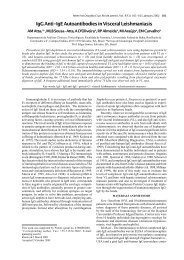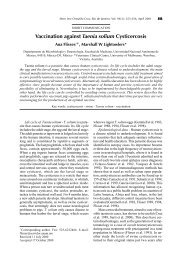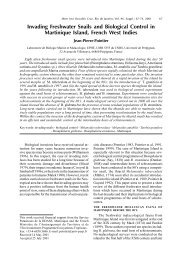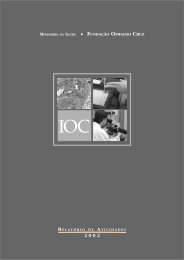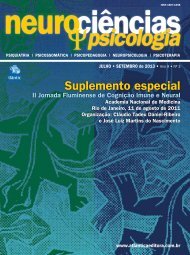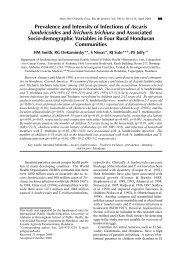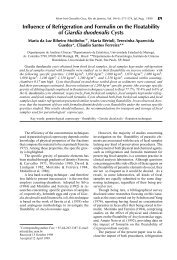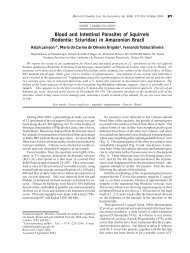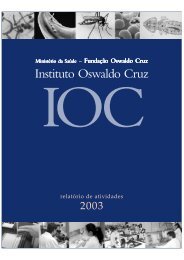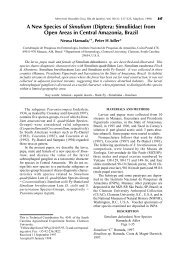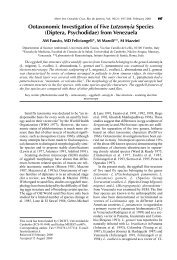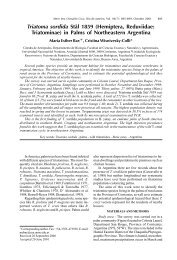The Schistosome Vectors in the Americas - SciELO
The Schistosome Vectors in the Americas - SciELO
The Schistosome Vectors in the Americas - SciELO
You also want an ePaper? Increase the reach of your titles
YUMPU automatically turns print PDFs into web optimized ePapers that Google loves.
Mem Inst Oswaldo Cruz, Rio de Janeiro, Vol. 96, Suppl., 2001<br />
13<br />
Lagunilla”, “of warm, little wavy, sal<strong>in</strong>e water”. End<strong>in</strong>g<br />
his description of A. eximia, Dunker (1853b)<br />
states that “accord<strong>in</strong>g to <strong>in</strong>formation of Mr. consul<br />
Gruner, from Bremen, <strong>the</strong> locality of this snail is <strong>the</strong><br />
prov<strong>in</strong>ce of Coro, on <strong>the</strong> lake of Maracaibo”. As a<br />
matter of fact, Coro is <strong>the</strong> capital of Falcón state,<br />
and lies about 250 km to <strong>the</strong> nor<strong>the</strong>ast of that lake.<br />
In May 1974 I collected <strong>in</strong> <strong>the</strong> o<strong>the</strong>r Lagunillas,<br />
situated 30 km west of Mérida city, a snail described<br />
as P. meridaensis by Preston (1907). Its shell resembles<br />
that of what is now called B. stram<strong>in</strong>ea,<br />
but anatomically it is <strong>in</strong>dist<strong>in</strong>guishable from B.<br />
prona (see Paraense 1992), described by Martens<br />
himself (1873) from lake Valencia, and whose shell<br />
is notably modified outside <strong>the</strong> lake (Paraense et al.<br />
1992).<br />
Summ<strong>in</strong>g up, almost certa<strong>in</strong>ly Martens’<br />
Lagunilla is <strong>the</strong> Venezuelan village on lake<br />
Maracaibo, whose sal<strong>in</strong>e water, derived from <strong>the</strong><br />
Caribbean sea through <strong>the</strong> gulf of Venezuela, communicates<br />
its sal<strong>in</strong>ity to <strong>the</strong> “Laguna von Lagunilla”<br />
mentioned by him. By <strong>the</strong> way, <strong>in</strong> nor<strong>the</strong>astern Brazil<br />
B. stram<strong>in</strong>ea has been found thriv<strong>in</strong>g <strong>in</strong> sal<strong>in</strong>e<br />
waters, 1-2 g NaCl/liter (Lucena 1946).<br />
It can be affirmed, however, that Cum<strong>in</strong>g had<br />
never been to Venezuela. His shell collect<strong>in</strong>g <strong>in</strong> <strong>the</strong><br />
<strong>Americas</strong> was restricted to <strong>the</strong> Pacific coast, from<br />
<strong>the</strong> island of Chiloé <strong>in</strong> Chile to Conchagua, <strong>in</strong> Honduras<br />
(see Dance 1986: 114).<br />
Martens (1873) refers to specimens of Planorbis<br />
stram<strong>in</strong>eus <strong>in</strong> <strong>the</strong> Museum of Berl<strong>in</strong>: from<br />
Lagunilla, collected by Engel; from Caracas, by<br />
Ernst; and from <strong>the</strong> Brazilian state of Ceará, by Zietz.<br />
Lutz (1928) considered P. stram<strong>in</strong>eus a snail found<br />
by him near Maracay, assert<strong>in</strong>g that it co<strong>in</strong>cided<br />
with <strong>the</strong> species so determ<strong>in</strong>ed by Martens. Of those<br />
localities <strong>the</strong> only one where B. stram<strong>in</strong>ea (as now<br />
def<strong>in</strong>ed) surely occurs is Ceará, where it is widespread.<br />
S<strong>in</strong>ce its presence <strong>in</strong> <strong>the</strong> o<strong>the</strong>r localities<br />
has not been confirmed, <strong>the</strong> name stram<strong>in</strong>ea is<br />
currently applied to <strong>the</strong> planorbid morphologically<br />
identical with <strong>the</strong> form occurr<strong>in</strong>g <strong>in</strong> Ceará.<br />
<strong>The</strong> next record of B. stram<strong>in</strong>ea is F Baker’s<br />
(1913), who collected it <strong>in</strong> lake Papari (Brazilian state<br />
of Rio Grande do Norte) and Ceará, referr<strong>in</strong>g to it as<br />
follows: “<strong>The</strong>re are about half a dozen very similar<br />
forms of Planorbis described from South America,<br />
not figured or imperfectly figured, quite possibly<br />
reducible to one or two species. Planorbis<br />
stram<strong>in</strong>eus Dunker seems to be <strong>the</strong> first of <strong>the</strong>se to<br />
be described”. Moreover, he records <strong>the</strong> occurrence<br />
of B. peregr<strong>in</strong>a (Orbigny, 1835) <strong>in</strong> <strong>the</strong> coastal<br />
region of Ceará, which has never been confirmed:<br />
its nor<strong>the</strong>rn limit is 15°S (Paraense 1966), whereas<br />
<strong>the</strong> sou<strong>the</strong>rn limit of Ceará is 8°S.<br />
Baker’s doubts mentioned above were also felt<br />
by Lutz (1918): “In <strong>the</strong> State of Pernambuco ... <strong>the</strong><br />
largest species of Planorbis are unknown, but a<br />
smaller one is widely spread, as well <strong>in</strong> rivers as <strong>in</strong><br />
ponds. Try<strong>in</strong>g to determ<strong>in</strong>e it, I found considerable<br />
difficulty. It looks somewhat like peregr<strong>in</strong>us<br />
D’ORB. of which F. BAKER mentions a specimen<br />
from Ceará which may belong to our species; <strong>the</strong><br />
true peregr<strong>in</strong>us, however, which I obta<strong>in</strong>ed <strong>in</strong><br />
Montevideo, is larger and differs by <strong>the</strong> form of<br />
<strong>the</strong> last whorl. BAKER also mentions stram<strong>in</strong>eus<br />
DUNKER as a species of Ceará, but its size and<br />
form do not agree, if <strong>the</strong> draw<strong>in</strong>g of REEVE-<br />
SOWERBY be correct. Without deny<strong>in</strong>g that this<br />
species may have been collected before, I do not<br />
th<strong>in</strong>k that it has been well def<strong>in</strong>ed, which obliges<br />
me to give it a name. I call it centimetralis to <strong>in</strong>dicate<br />
<strong>the</strong> size which, <strong>in</strong> this case, helps very much<br />
to recognize it”. (In <strong>the</strong> semiarid region of Brazilian<br />
Nor<strong>the</strong>ast I found specimens measur<strong>in</strong>g 15<br />
mm).<br />
As mentioned above, Lutz (1928) identified as<br />
P. stram<strong>in</strong>eus a planorbid collected by him near<br />
Maracay. S<strong>in</strong>ce he had erected <strong>the</strong> species<br />
centimetralis ten years before, differentiat<strong>in</strong>g it<br />
from stram<strong>in</strong>ea, a doubt rema<strong>in</strong>s about <strong>the</strong> true<br />
identity of those Venezuelan specimens. Such<br />
confusion about B. stram<strong>in</strong>ea and many species of<br />
planorbids and o<strong>the</strong>r molluscs results from <strong>the</strong> fact<br />
of <strong>the</strong>ir descriptions hav<strong>in</strong>g been based exclusively<br />
on shell characters.<br />
Still regard<strong>in</strong>g Venezuela, <strong>in</strong> December 1956<br />
(Paraense 1963) I collected B. stram<strong>in</strong>ea <strong>in</strong> San<br />
Joaquín, state of Carabobo (some specimens shedd<strong>in</strong>g<br />
cercariae of S. mansoni), from a creek at Hacienda<br />
Cura, where members of a family were <strong>in</strong>fected<br />
with <strong>the</strong> parasite. Malek (1969) mentions its presence<br />
<strong>in</strong> Guatire and Guaraymito, states of Miranda<br />
and Aragua, respectively.<br />
B. stram<strong>in</strong>ea is also present <strong>in</strong> Uruguay (Olazarri<br />
1984), Argent<strong>in</strong>a (Paraense 1970) and Paraguay<br />
(Paraense 1970).<br />
Outside South America (Figs 1, 2) B. stram<strong>in</strong>ea<br />
has been recorded <strong>in</strong> Mart<strong>in</strong>ique (Paraense 1970),<br />
Grenada (Richards 1973), Costa Rica (Paraense et<br />
al. 1981), Dom<strong>in</strong>ican Republic (Sodeman Jr et al.<br />
1985), Dom<strong>in</strong>ica (Noblet & Damian 1991) and<br />
Guadeloupe (Po<strong>in</strong>tier et al. 1993).<br />
In <strong>the</strong> Neotropical region <strong>the</strong>re is a planorbid –<br />
B. kuhniana (Cless<strong>in</strong>, 1883) – very similar to B.<br />
stram<strong>in</strong>ea, which so far has proved refractory to<br />
<strong>in</strong>fection with S. mansoni. Orig<strong>in</strong>ally described from<br />
Sur<strong>in</strong>ame, I collected it <strong>in</strong> Paramaribo and <strong>in</strong> localities<br />
on <strong>the</strong> Tocant<strong>in</strong>s river bas<strong>in</strong>, nor<strong>the</strong>rn Brazil<br />
(Paraense 1988), and also <strong>in</strong> Panama (Paraense<br />
1999), where it was named P. isthmicus by Pilsbry<br />
(1920). Samples labeled “B. stram<strong>in</strong>ea” from Venezuela<br />
and Colombia have been received for<br />
identification <strong>in</strong> this laboratory.




